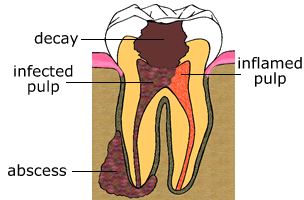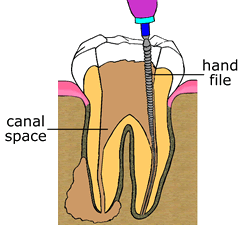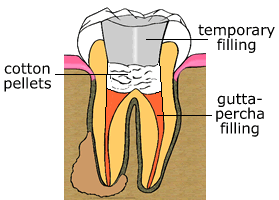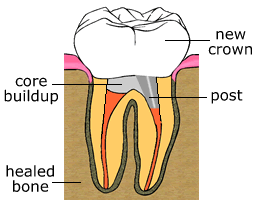Root Canal
Therapy
 When
the nerve of a tooth becomes infected or abscessed,
Root Canal Therapy is the only way to save the tooth. A tooth
can become abscessed as a result of deep
decay, a cracked tooth, or trauma
to the tooth. The only alternative to Root Canal Therapy is an Extraction. When
the nerve of a tooth becomes infected or abscessed,
Root Canal Therapy is the only way to save the tooth. A tooth
can become abscessed as a result of deep
decay, a cracked tooth, or trauma
to the tooth. The only alternative to Root Canal Therapy is an Extraction.
During Root Canal Therapy, the tooth is "numbed" (just like having
a filling). Then the unhealthy nerve
is removed and medication is placed in the tooth to treat the bacterial
abscess (infection). After the infection is removed and treated,
a filling is placed in the roots where the unhealthy nerve was.
A tooth that has undergone Root Canal Therapy is more brittle and
must be crowned to give the tooth sufficient
strength. The tooth is cared for in the same way as other natural
teeth. Brush and floss daily, and visit your dentist for regular
preventative dental check-ups.
High-Tech Root Canal Therapy
 |
The way root canal therapy is performed today
is vastly different than those done a few years ago, not to
mention a decade ago. The potential level for quality care has
dramatically increased. It is a thing of the past to do root
canals in five to six appointments, or by "touch or feel"
because we could not see. Root canals can be done painlessly,
faster, and more accurately due to the new technology available. |
Non-surgical Root Canal Therapy
 Root
Canal Therapy is a dental procedure, performed with local anesthetic,
which involves the removal of the nerve inside of the tooth because
it has become irreversibly damaged or infected. This is usually
due to the entry of bacteria into the centermost part of the tooth
called the dental pulp (nerve). ROOT CANAL is a commonly
used term for endodontic therapy or root canal therapy. This procedure
involves the removal of the entire nerve system, as well as cleaning,
shaping and 3-dimensional filling of the canal system with gutta
percha and a dental sealer. The procedure enables you to keep your
natural tooth, which is preferable to any type of replacement. Root
Canal Therapy is a dental procedure, performed with local anesthetic,
which involves the removal of the nerve inside of the tooth because
it has become irreversibly damaged or infected. This is usually
due to the entry of bacteria into the centermost part of the tooth
called the dental pulp (nerve). ROOT CANAL is a commonly
used term for endodontic therapy or root canal therapy. This procedure
involves the removal of the entire nerve system, as well as cleaning,
shaping and 3-dimensional filling of the canal system with gutta
percha and a dental sealer. The procedure enables you to keep your
natural tooth, which is preferable to any type of replacement.
Back to Top
What Happens During Root Canal Therapy?
 |
Step one:
After the tooth is "numbed", a small opening is
made into the pulp chamber. The canals are located and measured,
so they can be cleansed and shaped.
|
Step two:
The canals are filled with a rubber-like material called
gutta-percha and the opening is sealed with sterile cotton
pellets and a temporary filling.
|
 |
 |
Step three:
The tooth is typically restored within a couple of weeks.
A crown is placed over the treated tooth in order to protect
it, and if the tooth lacks sufficient tooth structure to hold
the core build-up, a post may be placed inside. Any areas
of infection around the roots will begin to heal.
|
The number of visits necessary to complete a root canal will vary
depending upon the degree of infection, the number of canals in
the tooth, if the canals are calcified, the anatomy of your tooth,
and the complexity of the procedure. We always strive to achieve
the best possible result; therefore, your treatment may take one
visit, or it may take more.
|
